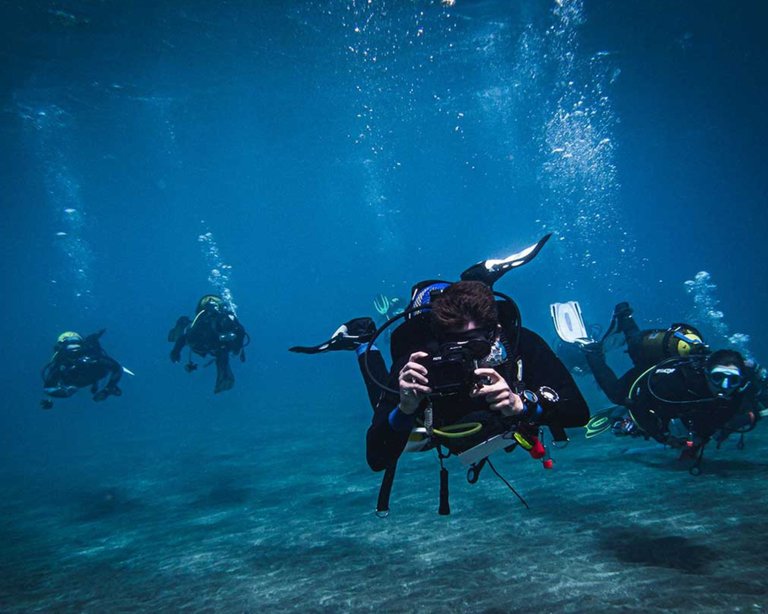The mysterious depths of the ocean and the role of the marine geologist (ESP-ENG)

Español
El fondo oceánico alberga una variedad asombrosa de sedimentos, desde arenas y lodos hasta diminutos seres vivos como el plancton y los foraminíferos. ¿Conocías de estos tipos de organismos?
English
The ocean floor is home to an amazing variety of sediments, from sands and muds to tiny living things such as plankton and foraminifera. Did you know about these types of organisms?

Different plankton organisms

Benthic and planktonic foraminifers


Fluorescent plankton in the Maldives
Bueno, por si no lo sabías, el plancton es un conjunto de organismos muy numerosos y diversos que habitan tanto en aguas dulces como en aguas saladas. Es muy común encontrarlos en los océanos y puede haber más de ellos en mares fríos. Sin embargo, también pueden vivir en aguas dulces como lagos, charcas o embalses, ya que en zonas con corriente serían arrastrados.
Well, in case you didn't know, plankton is a very numerous and diverse set of organisms that inhabit both fresh and salt waters. It is very common to find them in the oceans and there may be more of them in cold seas. However, they can also live in fresh waters such as lakes, ponds or reservoirs, as they would be washed away in areas with currents.
En cambio, los foraminíferos son organismos unicelulares numerosos y heterogéneos que habitan en los mares, al menos la gran mayoría de ellos, aunque existen algunos que tienen la capacidad para vivir en agua dulce. En su hábitat, pueden hallarse tanto en el suelo o fondo (bentónicos), como en la columna o superficie de agua (planctónicos). Los bentónicos son los más numerosos, diversos y pueden estar localizados hasta los 15 cm de profundidad del fondo océanico.
On the other hand, foraminifera are numerous and heterogeneous unicellular organisms that inhabit the seas, at least the great majority of them, although there are some that have the capacity to live in fresh water. In their habitat, they can be found both in the soil or bottom (benthic) and in the water column or surface (planktonic). The benthic ones are the most numerous, diverse and can be located up to 15 cm deep on the ocean floor.

Benthic foraminifera genus
Tanto el plancton como los foraminíferos tienen gran importancia para el medioambiente de forma general. Por ejemplo, el plancton se sitúa en la base de la cadena trófica marina ya que es el principal alimento de muchas especies marinas y terrestres. Forman parte de los ciclos biogeoquímicos y regulan el clima. Además, cuando el plancton muere, cae al fondo del océano y crea una capa de sedimento que una vez fosilizado después de miles de años da lugar al petróleo.
Por otro lado, los foraminíferos constituyen uno de los indicadores más importantes de la historia geológica y evolutiva del planeta, al ser organismos de mucha antigüedad de los que queda aún registro fósil. De esta manera, son útiles en análisis bioestratigráficos, paleoambiantes y paleoceanográficos.
Both plankton and foraminifera are of great importance to the environment in general. For example, plankton are at the base of the marine food chain as they are the main food for many marine and terrestrial species. They are part of biogeochemical cycles and regulate climate. In addition, when plankton die, they fall to the bottom of the ocean and create a layer of sediment that, once fossilized after thousands of years, gives rise to oil.
On the other hand, foraminifera are one of the most important indicators of the geological and evolutionary history of the planet, being organisms of great antiquity of which there is still a fossil record. Thus, they are useful in biostratigraphic, paleoenvironmental and paleoceanographic analyses.
Los intrépidos geólogos marinos están convencidos de que el conocimiento que podemos obtener a partir de estos y otros organismos, justifican cualquier riesgo. Su pasión para descubrir respuestas nuevas cada día y desvelar tesoros ocultos es su motor impulsor. A pesar de las tormentas, los peligros y las especies extrañas que puedan encontrar, nada puede apagar esa pasión que los impulsa a explorar los rincones más oscuros del océano, dejando su huella en la historia gracias a la ciencia y el descubrimiento. Por ello, emplean herramientas y métodos especializados para estudiar las propiedades físicas y químicas del lecho oceánico. Una de las herramientas más reconocidas de estas investigaciones es el barco oceanográfico, un aliado indispensable para los expertos en el campo.
Intrepid marine geologists are convinced that the knowledge we can gain from these and other organisms justifies any risk. Their passion to discover new answers every day and uncover hidden treasures is their driving force. Despite the storms, dangers and strange species they may encounter, nothing can dampen that passion that drives them to explore the darkest corners of the ocean, leaving their mark on history through science and discovery. That is why they employ specialized tools and methods to study the physical and chemical properties of the ocean floor. One of the most recognized tools of this research is the oceanographic vessel, an indispensable ally for experts in the field.

Oceanographic vessel of Argentina

Aún quedan muchas maravillas para revelar en las profundidades ocultas del océano. Se sabe que muchos metales estratégicos para nuestro uso en la Tierra se encuentran en los fondos marinos. Sorprendentemente, el 96% de las reservas conocidas de cobalto, el 84 % de níquel y el 79 % de manganeso se hallan precisamente en estas zonas.
There are still many wonders to be revealed in the hidden depths of the ocean. Many strategic metals for our use on Earth are known to be found in the deep sea. Surprisingly, 96% of the known reserves of cobalt, 84% of nickel and 79% of manganese are found precisely in these areas.


Example of seamount
Uno de los misterios que todavía desafía a los científicos son los montes marinos, elevaciones sumergidas que pueden estar aisladas o formar archipiélagos. Los montes marinos constituyen hábitats únicos que albergan una biodiversidad asombrosa y sirven como refugio para diversas formas de vida. Desafortunadamente, la actividad humana está poniendo en peligro la existencia de muchos organismos marinos. El océano, que absorbe dióxido de carbono presente en el aire, se vuelve cada vez más ácido. Este fenómeno amenaza enormemente a las criaturas marinas y su equilibrio delicado.
La geología marina es un campo fascinante y repleto de complejidades. El papel del geólogo es descubrir sus misterios y asegurarse de que los recursos se exploren de manera responsable y sostenible, solo así podremos apreciar toda su belleza e importancia.
One of the mysteries that still challenges scientists are seamounts, submerged elevations that may be isolated or form archipelagos. Seamounts are unique habitats that harbor amazing biodiversity and serve as refuges for diverse life forms. Unfortunately, human activity is endangering the existence of many marine organisms. The ocean, which absorbs carbon dioxide present in the air, is becoming increasingly acidic. This phenomenon greatly threatens marine creatures and their delicate balance.
Marine geology is a fascinating field full of complexities. The role of the geologist is to uncover its mysteries and ensure that the resources are explored responsibly and sustainably, only then can we appreciate their full beauty and importance.

This is an article prepared for the dissemination of geosciences (as all the blogs of this community), not a scientific-technical material for the geoscientific community. I greatly appreciate the help of Miguel Cabrera Castellanos, Specialist in Marine Geology. The text has been translated into English through the translator DeepL.**